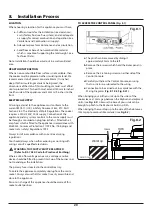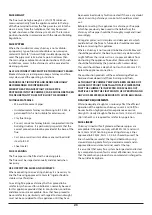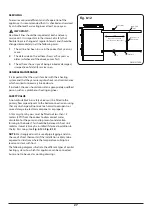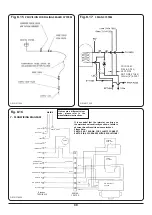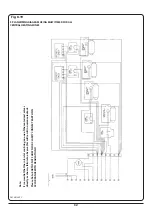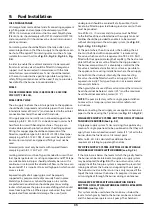
24
FACTORY MADE INSULATED CHIMNEYS
Factory-made insulated chimneys should be constructed and
tested to meet the relevant standards and recommendations
given in:
•
B.S. 7566 - Installation of factory-made chimneys
conforming to B.S. 4543 for domestic appliances.
•
Part 1: Method of specifying installations design
information.
•
Part 2: Specification for installation design.
•
Part 3: Specification for site installation.
•
Part 4: Recommendation for installation design and
installation.
VENTILATION & COMBUSTION AIR REQUIREMENTS
1.
It is imperative that there is sufficient air supply to
the burners of the cooker in order to support correct
combustion.
2.
The air supply to this appliance must comply with BS
5410 Part 1.
3.
The minimum effective air requirement for this
appliance is 215 cm2 (100), 193 cm2 (80) or 155cm2
(60). When calculating combustion air requirements
for this appliance use the following equation: 550mm2
per kW of maximum rated output above 5kW. These
requirements are illustrated in OFTEC Technical Book
No. 3 & B.S. 5410.
4.
If there is another appliance using air fitted in the same
or adjacent room, it will be necessary to refer to B.S.
5410 to calculate the additional air supply.
5.
All materials used in the manufacture of air vents
should be such that the vent is dimensionally stable and
corrosion resistant.
6.
Air vents direct to the outside of the building should
be located so that any air current produced will not
pass through normally occupied areas of the room.
An air vent outside the building should not be located
less than the dimensions specified within the Building
Regulations (See Technical Data) from any part of any
flue terminal. These air vents must also be satisfactorily
fire proofed as per Building Regulations.
7.
Air vents in internal walls should not communicate
with bedrooms, bedsits, toilets, bathrooms or rooms
containing a shower.
8.
Air vents traversing cavity walls should include a
continuous duct across the cavity. The duct should be
installed in such a manner as not to impair the weather
resistance of the cavity.
9.
Joints between air vents and outside walls should be
sealed to prevent the ingress of moisture. Existing air
vents should be of the correct size and unobstructed for
the appliance in use.
10.
If there is an air extraction fan fitted in the room or
adjacent rooms where this appliance is fitted, additional
air vents will be required to aleviate the possibility of
spillage of combustion products from the appliance/
flue while the fan is in operation. (Refer B.S. 5410).
11.
Where such an installation exists, a test for spillage
should be made with the fan or fans and other burning
appliances in operation at full rate (i.e. extraction fans,
tumble dryers) with all external doors and windows
closed.
12.
If spillage occurs following the above operation, an
additional air vent of sufficient size to prevent this
occurrence should be installed.
OUTSIDE AIR CONNECTION
If this option is used additional air as indicated in BS 5410 is
not required.
1.
This appliance may be connected direct to the outside
of the house for its combustion air supply.
2.
Remove the blanking plate located at the back right
hand corner and remove the primary air grill located at
the front right hand corner. Fix the blanking plate over
the front primary air inlet. (See
3.
Connect the optional 125mm (5”) spigot to the base.
(See
).
4.
To connect this appliance to an outside air supply use
either 125mm (5”) rigid or flexible stainless steel pipes
or non-combustible corrosion-resistant materials not
more than 965mm (38”) in length and having no sharp
bends or corners other than the down turn at the
terminus.
5.
Air inlets traversing cavity walls should include a
continuous duct across the cavity. The duct should be
installed in such a manner as not to impair the weather
resistance of the cavity.
6.
Joints between air vents and outside walls should be
sealed to prevent ingress of moisture.
HEATING
PIPE FITTINGS
Materials used for insulation work should be fire resistant.
Standards should conform to all appropriate regulations in
force at the time and place of installation.
1.1
Ferrous Materials
BS 1387 Steel tubes.
BS 1740 Steel pipe fittings.
BS 4127 Stainless steel tubes.
BS 6956 Jointing Materials.
2.2
Non-Ferrous Materials
EN 29453 Soft Solder Alloys.
BS 864 Compression tube fittings.
BS 2871 & BS EN 1057 Copper & Copper
Alloys.











